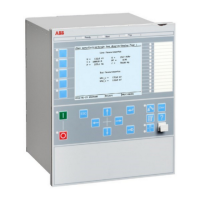5. Repeat steps 1 and 2. Then slowly increase the measured current in one phase
until the BLKU signal disappears.
6.
Record the measured current and calculate the corresponding negative-
sequence current according to the equation (observe that the currents in the
equation are phasors):
2
1 2 32
3
L L L
I I a I a I× = + × + ×
IECEQUATION00021 V1 EN-US (Equation 105)
Where:
IECEQUATION00020 V1 EN-US
are the measured phase currents
2
3
3
1 0,5
2
j
a e j
p
×
= × = - +
IECEQUATION00022 V2 EN-US
7. Compare the result with the set value of the negative-sequence operating
current. Consider that the set value 3I2< is in percentage of the base current
IBase.
11.9.2.3 Measuring the operate
value for the zero-sequence function
M1405-72 v11
Measure the operate value for the zero-sequence function, if included in the IED.
1. Simulate normal operating conditions with the three-phase currents in phase
with their corresponding phase voltages and with all of them equal to their
rated values.
2. Slowly decrease the measured voltage in one phase until the BLKU signal
appears.
3. Record the measured voltage and calculate the corresponding zero-sequence
voltage according to the equation (observe that the voltages in the equation
are phasors):
IEC00000276 V1 EN-US (Equation 106)
Where:
IEC00000275 V1 EN-US
are the measured phase voltages
4. Compare the result with the set value of the zero-sequence operating voltage
(consider that the set value 3U0> is in percentage of the base voltage.)
1MRK 505 378-UEN A Section 11
Testing functionality by secondary injection
Line differential protection RED670 2.2 IEC 217
Commissioning manual

